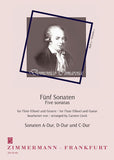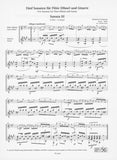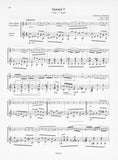Five Sonatas, Volume 2 - OB/GUITAR or FL/GUITAR
Composer: Cimarosa, Domenico
Publisher: Zimmerman (Germany)
Edition: 69935
$32.95
Five Sonatas, Volume 2
for oboe (or flute) and guitar
by Domenico Cimarosa (1749-1801) - Italian composer
Edited by Carsten Linck. In addition to some 70 operas, Domenico Cimarosa’s compositions include liturgical music, but also chamber music as well as 32 one-movement sonatas for harpsichord. The musical roots of Cimarosa’s harpsichord sonatas are to be found on the one hand in the Italian toccatas and capriccios and on the other hand in the many canzoni. It is from the former that they derive their technical ornamentation, their virtuosity and their occasionally improvisational character, from the latter their vocality and sense of tone, to be played for social entertainment or for instructional purposes. The sonatas were just asking to be arranged for flute and guitar, since the melodies (right hand on harpsichord) are ideally suited for playing on a wind instrument and the accompaniment (left hand on harpsichord) can easily be arranged for the guitar. Quite in keeping with the custom of that time, cyclical works have been formed by combining several pieces in each case, which involved partially transposing individual movements. The sonatas are nice entertaining pieces not too difficult and very effective in performance.
Volume 1, containing the first two sonatas is available HERE.
for oboe (or flute) and guitar
by Domenico Cimarosa (1749-1801) - Italian composer
Sonata III in A Major
I. Allegro moderato
II. Andante
III. Allegretto
IV. Allegro
Sonata IV in D Major
I. Allegro
II. Adagio
III. Allegro
Sonata V in C Major
I. Allegretto
II. Allegro
III. Andante
IV. Presto
Edited by Carsten Linck. In addition to some 70 operas, Domenico Cimarosa’s compositions include liturgical music, but also chamber music as well as 32 one-movement sonatas for harpsichord. The musical roots of Cimarosa’s harpsichord sonatas are to be found on the one hand in the Italian toccatas and capriccios and on the other hand in the many canzoni. It is from the former that they derive their technical ornamentation, their virtuosity and their occasionally improvisational character, from the latter their vocality and sense of tone, to be played for social entertainment or for instructional purposes. The sonatas were just asking to be arranged for flute and guitar, since the melodies (right hand on harpsichord) are ideally suited for playing on a wind instrument and the accompaniment (left hand on harpsichord) can easily be arranged for the guitar. Quite in keeping with the custom of that time, cyclical works have been formed by combining several pieces in each case, which involved partially transposing individual movements. The sonatas are nice entertaining pieces not too difficult and very effective in performance.
Volume 1, containing the first two sonatas is available HERE.











Share this item: